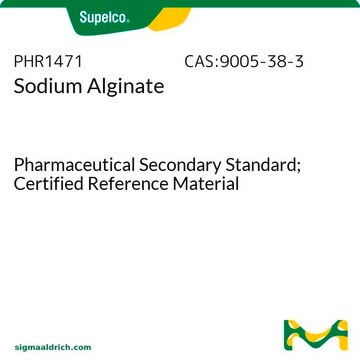Products may be shipped at a different temperature than the recommended long-term storage temperature. If the product quality is sensitive to short-term exposure to conditions other than the recommended long-term storage, it will be shipped on wet or dry-ice. If the product quality is NOT affected by short-term exposure to conditions other than the recommended long-term storage, it will be shipped at ambient temperature. As shipping routes are configured for minimum transit times, shipping at ambient temperature helps control shipping costs for our customers. For more information, please refer to the Storage and Transport Conditions document: https://www.sigmaaldrich.com/deepweb/assets/sigmaaldrich/marketing/global/documents/316/622/storage-transport-conditions-mk.pdf
71238
Alginic acid sodium salt from brown algae
BioReagent, suitable for immobilization of micro-organisms
Sinonimo/i:
Algin, Sodium alginate
Scegli un formato
Scegli un formato
About This Item
Prodotti consigliati
Origine biologica
algae (brown)
Nome Commerciale
BioReagent
Stato
powder
Residuo alla calcinazione
≤30%
Perdita
≤15% loss on drying
Colore
white to light beige
pH
6.0-8.0 (10 mg/mL in H2O)
Compatibilità
in accordance for gelation test
suitable for immobilization of micro-organisms
Temperatura di conservazione
room temp
Stringa SMILE
[Na+].[O-]C(=O)C1O[C@H]([C@H]([C@H]([C@@H]1O)O)O)O
InChI
1S/C6H10O7.Na/c7-1-2(8)4(5(10)11)13-6(12)3(1)9;/h1-4,6-9,12H,(H,10,11);/q;+1/p-1/t1-,2-,3-,4?,6+;/m0./s1
MSXHSNHNTORCAW-MPGIDXPLSA-M
Cerchi prodotti simili? Visita Guida al confronto tra prodotti
Applicazioni
Altre note
Codice della classe di stoccaggio
11 - Combustible Solids
Classe di pericolosità dell'acqua (WGK)
WGK 1
Punto d’infiammabilità (°F)
Not applicable
Punto d’infiammabilità (°C)
Not applicable
Dispositivi di protezione individuale
Eyeshields, Gloves, type N95 (US)
Scegli una delle versioni più recenti:
Possiedi già questo prodotto?
I documenti relativi ai prodotti acquistati recentemente sono disponibili nell’Archivio dei documenti.
-
How is shipping temperature determined? And how is it related to the product storage temperature?
1 answer-
Helpful?
-
-
How can I determine the shelf life / expiration / retest date of this product?
1 answer-
If this product has an expiration or retest date, it will be shown on the Certificate of Analysis (COA, CofA). If there is no retest or expiration date listed on the product's COA, we do not have suitable stability data to determine a shelf life. For these products, the only date on the COA will be the release date; a retest, expiration, or use-by-date will not be displayed.
For all products, we recommend handling per defined conditions as printed in our product literature and website product descriptions. We recommend that products should be routinely inspected by customers to ensure they perform as expected.
For products without retest or expiration dates, our standard warranty of 1 year from the date of shipment is applicable.
For more information, please refer to the Product Dating Information document: https://www.sigmaaldrich.com/deepweb/assets/sigmaaldrich/marketing/global/documents/449/386/product-dating-information-mk.pdfHelpful?
-
-
What is the viscosity of the alginate?
1 answer-
The viscosity is not determined for this product on a lot specific basis. However, the viscosity is generally between 100 - 200 mPa sec for a 1% solution at 20°C. Please note that the viscosity is not a listed test specification and has not been validated.
Helpful?
-
-
What is the viscosity of this product?
1 answer-
The viscosity of product is not tested on a lot specific basis, however historical values indicate a range of 100 - 200 cP at 1% in water, 20 °C.
Helpful?
-
-
WHAT IS THE MANNURONIC ACID TO GULURONIC ACID (M/G) RATIO OF THIS PRODUCT (71238)?
1 answer-
The guluronic acid content in this product is approximately 70 % and the mannuronic acid content is approximately 30 %
Helpful?
-
-
What is the average molecular weight?
1 answer-
The molecular weight is approx. 100,000 - 200,000 g/moL.
Helpful?
-
Active Filters
Il team dei nostri ricercatori vanta grande esperienza in tutte le aree della ricerca quali Life Science, scienza dei materiali, sintesi chimica, cromatografia, discipline analitiche, ecc..
Contatta l'Assistenza Tecnica.






